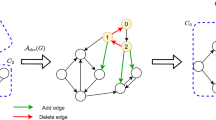Abstract
Community detection is used to determine the network structure and node relationships. However, it raises privacy concerns when locating and disclosing the members’ personal or community information. Community deception is a method of hiding a target community from community detection algorithms. It is accomplished by minimally rewiring the edges of the community in the network. In this paper, we propose PERMDEC, a novel community deception algorithm that operates on a weighted undirected network. PERMDEC determines which edges of a given community should be modified based on the parameter permanence loss and updates the network to hide a specific community. We tested PERMDEC on five community detection algorithms on eight real datasets with varying budget values. The performance is compared to the baseline method SECRETORUM using the deception score and NMI. In general, PERMDEC outperforms the existing method of deception for weighted networks.





Similar content being viewed by others
References
Blondel VD, Guillaume JL, Lambiotte R, Lefebvre E (2008) Fast unfolding of communities in large networks. J Stat Mech Theory Exp 10:P10008
Brandes U, Delling D, Gaertler M, Gorke R, Hoefer M, Nikoloski Z, Wagner D (2007) On modularity clustering. IEEE Trans Knowl Data Eng 20(2):172–188
Chakraborty T, Srinivasan S, Ganguly N, Mukherjee A, Bhowmick S (2014) On the permanence of vertices in network communities. In: Proceedings of the 20th ACM SIGKDD international conference on knowledge discovery and data mining, association for computing machinery, New York, NY, USA, KDD vol 14, pp 1396–1405, https://doi.org/10.1145/2623330.2623707
Chakraborty T, Srinivasan S, Ganguly N, Mukherjee A, Bhowmick S (2016) Permanence and community structure in complex networks. CoRR abs/1606.01543, http://arxiv.org/abs/1606.01543, 1606.01543
Chen X, Jiang Z, Li H, Ma J, Yu PS (2021) Community hiding by link perturbation in social networks. IEEE Trans Comput Soc Syst 8(3):704–715. https://doi.org/10.1109/TCSS.2021.3054115
Chin JH, Ratnavelu K (2022) Community detection using constrained label propagation algorithm with nodes exemption. Computing 104:339–358. https://doi.org/10.1007/s00607-021-00966-2
Danon L, Díaz-Guilera A, Duch J, Arenas A (2005) Comparing community structure identification. J Stat Mech Theory Exp 09:P09008–P09008. https://doi.org/10.1088/1742-5468/2005/09/p09008
El-moussaoui M, Agouti T, Tikniouine A, Adnani ME (2019) A comprehensive literature review on community detection: approaches and applications. Procedia Computer Science vol 151, pp 295–302, the 10th international conference on ambient systems, networks and technologies (ANT 2019) / The 2nd international conference on emerging data and industry 4.0 (EDI40 2019) / Affiliated workshops https://doi.org/10.1016/j.procs.2019.04.042, https://www.sciencedirect.com/science/article/pii/S1877050919305046
Fionda V, Pirrò G (2016) From community detection to community deception. CoRR abs/1609.00149, http://arxiv.org/abs/1609.00149, 1609.00149
Fionda V, Pirró G (2021) Community deception in weighted networks. In: Proceedings of the 2021 IEEE/ACM international conference on advances in social networks analysis and mining, association for computing machinery, New York, NY, USA, ASONAM vol 21, pp 278–282, https://doi.org/10.1145/3487351.3488337
Fionda V, Pirró G, (2022) Community deception in networks: where we are and where we should go. Complex networks & their applications x complex networks, (2021) Studies in computational intelligence, vol 1016. Springer, Cham
Fionda V, Pirró G (2018) Community deception or: how to stop fearing community detection algorithms. IEEE Trans Knowl Data Eng 30(4):660–673. https://doi.org/10.1109/TKDE.2017.2776133
Liu Y, Liu J, Zhang Z, Zhu L, Li A (2019) Rem: from structural entropy to community structure deception. In: Advances in neural information processing systems, Curran Associates, Inc., Brooklyn, vol 32
Mittal S, Sengupta D, Chakraborty T (2021) Hide and seek: outwitting community detection algorithms. IEEE Trans Comput Soc Syst 8(4):799–808. https://doi.org/10.1109/TCSS.2021.3062711
Nagaraja S (2010) The impact of unlinkability on adversarial community detection: effects and countermeasures. In: Privacy enhancing technologies. PETS 2010. Lecture notes in computer science, vol 6205, pp 253–272, https://doi.org/10.1007/978-3-642-14527-8_15
Nallusamy K, Easwarakumar KS (2022) CGRAM: enhanced algorithm for community detection in social networks. Intell Autom Soft Comput 31(2):749–765, https://doi.org/10.32604/iasc.2022.020189, http://www.techscience.com/iasc/v31n2/44541
Newman ME (2004) Fast algorithm for detecting community structure in networks. Phys Rev E 69(6):066133
Newman ME (2006) Finding community structure in networks using the eigenvectors of matrices. Phys Rev E 74(3):036104
Newman MEJ (2006b) Modularity and community structure in networks. Proc Natl Acad Sci 103(23):8577–8582, https://doi.org/10.1073/pnas.0601602103, https://www.pnas.org/content/103/23/8577.full.pdf
Onnela JP, Saramäki J, Kertész J, Kaski K (2005) Intensity and coherence of motifs in weighted complex networks. Phys Rev E 71:065103. https://doi.org/10.1103/PhysRevE.71.065103
Pons P, Latapy M (2005) Computing communities in large networks using random walks. In: Computer and information sciences-ISCIS 2005: 20th international symposium, Istanbul, Turkey, October 26-28, 2005. Proceedings 20, Springer, pp 284–293
Raghavan UN, Albert R, Kumara S (2007) Near linear time algorithm to detect community structures in large-scale networks. Phys Rev E 76(3):036106
Rosvall M, Axelsson D, Bergstrom CT (2009) The map equation. Eur Phys J Special Topics 178(1):13–23
Saramäki J, Kivelä M, Onnela JP, Kaski K, Kertész J (2007) Generalizations of the clustering coefficient to weighted complex networks. Phys Rev E 75:027105. https://doi.org/10.1103/PhysRevE.75.027105
Shirjini M, Farzi S, Nikanjam A (2020) MDPcluster: a swarm-based community detection algorithm in large-scale graphs. Computing 102:893–922. https://doi.org/10.1007/s00607-019-00787-4
Waniek M, Michalak TP, Rahwan T, Wooldridge MJ (2016) Hiding individuals and communities in a social network. CoRR abs/1608.00375, http://arxiv.org/abs/1608.00375
Funding
The authors did not receive support from any organization for the submitted work.
Author information
Authors and Affiliations
Corresponding author
Ethics declarations
Conflict of interest
The authors declare that they have no conflict of interest.
Additional information
Publisher's Note
Springer Nature remains neutral with regard to jurisdictional claims in published maps and institutional affiliations.
Rights and permissions
Springer Nature or its licensor (e.g. a society or other partner) holds exclusive rights to this article under a publishing agreement with the author(s) or other rightsholder(s); author self-archiving of the accepted manuscript version of this article is solely governed by the terms of such publishing agreement and applicable law.
About this article
Cite this article
Nallusamy, K., Easwarakumar, K.S. PERMDEC: community deception in weighted networks using permanence. Computing 106, 353–370 (2024). https://doi.org/10.1007/s00607-023-01223-4
Received:
Accepted:
Published:
Issue Date:
DOI: https://doi.org/10.1007/s00607-023-01223-4




